Installation views of Nightshades, 2021
Spraypaint on aluminium honeycomb grids and wired safety glass
Various sizes
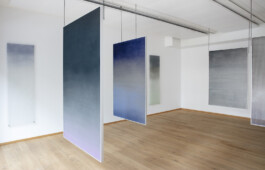
You darkness, that I come from,
I love you more than all the fires
that fence in the world,
for the fire makes
a circle of light for everyone,
and then no one outside learns of you.
But the darkness pulls in everything:
shapes and fires, animals and myself,
how easily it gathers them! —
powers and people —
and it is possible a great energy
is moving near me.
I have faith in nights.
Rainer Maria Rilke (1899)
Translation by Robert Bly
In her first solo exhibition Nightshades at Livie Fine Art, Esther Mathis (*1985) explores the mesopic realm of our perception. Photopic vision refers to human vision when there is sufficient brightness. This contrasts with scotopic vision, also called night vision, in low light. The main difference between day and night vision is the perception of colors during day light, while no colors are perceived during night vision when luminance is insufficient. Now, however, our urban nights are no longer dark; due to the possibilities of electricity since the modern era, a constant state of twilight is created, an intermediate or transitional area in which mesopic vision or twilight vision becomes the important optical instrument of mankind. Marking the exit of humans from their cave existence according to Plato. The red of the flame gives way to the blue of night.
Blue tones appear much more luminous in twilight vision. For the same reason, moonlight appears "colder" (bluer) than sunlight, although the color stimulus is slightly more reddish. The disappearance of color perception as darkness increases is aptly summarized in the saying "all cats are gray at night." In artistic representations of the early 20th century, or even in lighting for film and television shoots, a nighttime atmosphere is created by a higher proportion of blue color shades. This trick is called "American night," a term that refers both to the origins of urban street lighting using electricity, and to the early film studios that had to illuminate color film. The honeycomb structure of the support media in Mathis' almost architectural intervention is derived from movie lighting techniques, as their original purpose is to focus light. A contradiction that the artist appropriates to reshape this medium into actual bodies of light. Hence Mathis' minimal and concentrated show is typical of the artist's working method. She explores optical devices and perception, light and shadow, the influence of light refraction and light direction on art, as well as the phenomenology of being human.
Which colors does the night have? Is this more of a physical-morphological question or a poetic one? Visual acuity is greatest in photopic vision, less so in scotopic vision; details with low contrast can no longer be perceived because the eye interpolates brightness. This optical-physical process is at the same time a poetic one; the colors of the RAL palette that Mathis diffuses on her honeycombs bear names such as “night redness”, “moon ash green”, “full moon gray”, “midnight blue”, “nightshade violet” or “pearl night blue”. The mesopic range consists of intermediate tones, transitions and interpolation. We create the colors ourselves as we simulate visual acuity. This is an actual artistic act that Mathis introduces us to. At the same time, she subverts physical phenomena, questions them, and creates a new, alternative history of light as part of the opaque, the shadow, and the tonality of night. The history of knowledge and Enlightenment is turned upside down, the hegemonies of a masculinely connoted epistemology expanded and shattered. Rilke's flame is freed from the narrow circle of perception and reconciled with darkness. The Nightshades of Esther Mathis create an intermediate space of even, platonic light.
Damian Christinger
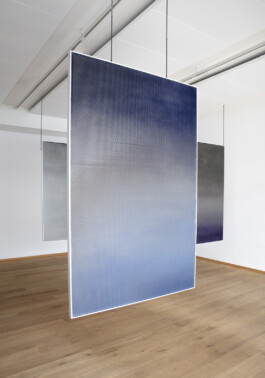
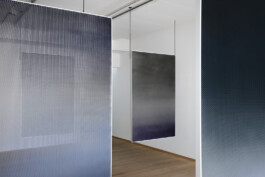
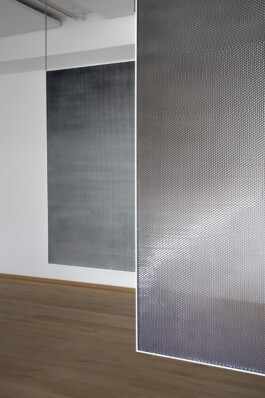
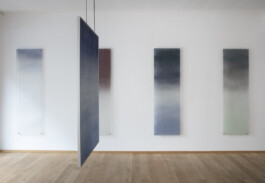
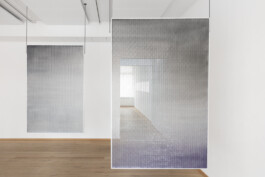

Installation views of Nightshades, 2021
Spraypaint on aluminium honeycomb grids and wired safety glass
Various sizes
You darkness, that I come from,
I love you more than all the fires
that fence in the world,
for the fire makes
a circle of light for everyone,
and then no one outside learns of you.
But the darkness pulls in everything:
shapes and fires, animals and myself,
how easily it gathers them! —
powers and people —
and it is possible a great energy
is moving near me.
I have faith in nights.
Rainer Maria Rilke (1899)
Translation by Robert Bly
In her first solo exhibition Nightshades at Livie Fine Art, Esther Mathis (*1985) explores the mesopic realm of our perception. Photopic vision refers to human vision when there is sufficient brightness. This contrasts with scotopic vision, also called night vision, in low light. The main difference between day and night vision is the perception of colors during day light, while no colors are perceived during night vision when luminance is insufficient. Now, however, our urban nights are no longer dark; due to the possibilities of electricity since the modern era, a constant state of twilight is created, an intermediate or transitional area in which mesopic vision or twilight vision becomes the important optical instrument of mankind. Marking the exit of humans from their cave existence according to Plato. The red of the flame gives way to the blue of night.
Blue tones appear much more luminous in twilight vision. For the same reason, moonlight appears "colder" (bluer) than sunlight, although the color stimulus is slightly more reddish. The disappearance of color perception as darkness increases is aptly summarized in the saying "all cats are gray at night." In artistic representations of the early 20th century, or even in lighting for film and television shoots, a nighttime atmosphere is created by a higher proportion of blue color shades. This trick is called "American night," a term that refers both to the origins of urban street lighting using electricity, and to the early film studios that had to illuminate color film. The honeycomb structure of the support media in Mathis' almost architectural intervention is derived from movie lighting techniques, as their original purpose is to focus light. A contradiction that the artist appropriates to reshape this medium into actual bodies of light. Hence Mathis' minimal and concentrated show is typical of the artist's working method. She explores optical devices and perception, light and shadow, the influence of light refraction and light direction on art, as well as the phenomenology of being human.
Which colors does the night have? Is this more of a physical-morphological question or a poetic one? Visual acuity is greatest in photopic vision, less so in scotopic vision; details with low contrast can no longer be perceived because the eye interpolates brightness. This optical-physical process is at the same time a poetic one; the colors of the RAL palette that Mathis diffuses on her honeycombs bear names such as “night redness”, “moon ash green”, “full moon gray”, “midnight blue”, “nightshade violet” or “pearl night blue”. The mesopic range consists of intermediate tones, transitions and interpolation. We create the colors ourselves as we simulate visual acuity. This is an actual artistic act that Mathis introduces us to. At the same time, she subverts physical phenomena, questions them, and creates a new, alternative history of light as part of the opaque, the shadow, and the tonality of night. The history of knowledge and Enlightenment is turned upside down, the hegemonies of a masculinely connoted epistemology expanded and shattered. Rilke's flame is freed from the narrow circle of perception and reconciled with darkness. The Nightshades of Esther Mathis create an intermediate space of even, platonic light.
Damian Christinger




